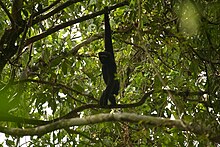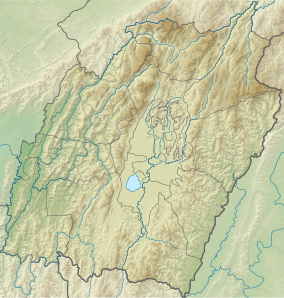|
Yangoupokpi-Lokchao Wildlife Sanctuary
Yangoupokpi-Lokchao Wildlife Sanctuary (Meitei: Yangoupokpi-Lokchao Lamlak-ki Saa-Ngaa Ngaak Senpham) is an Indo-Burma wildlife sanctuary in Chandel district of Manipur. It is in the Indo-Myanmar border about 110 km from Imphal. It has an area of 184.80 square kilometers.[1][2][3] The ecosystem of this wildlife sanctuary is unique and vibrant. It represents the Indo-Myanmar biological diversity (Indo-Burma). It is because of the strategic location of the wildlife sanctuary in the meeting point of the two major geographical zones, India and Myanmar (Burma).[4] HistoryYangoupokpi-Lokchao Wildlife Sanctuary was established in the year 1989.[5][6] Fauna Hoolock gibbon (Meitei: "Yongmoo" or "Yongmu") is the only ape species found in India. It lives in this wildlife sanctuary. Others include wild bear (Meitei: Lamlakki Sawom), Himalayan Black Bear (Meitei: Himalayagi Amuba Sawom), Malayan Sun Bear (Meitei: Malayagi Numit Sawom), Slow loris (Meitei: "Yong Ikaithibi") or (Meitei: "Loudraubi"), Stump-tailed macaque, Serow, Indian Civet cat, Common otter (Eurasian otter), pangolin, leopard (Meitei: Kabokkei). Sometimes, elephants (Meitei: Shamu) also migrated from the Indo-Myanmar border.[4][7] Visiting seasonsThe best season to visit the sanctuary is from October to April. The best time to visit is during the early morning.[4] Rest housesThere are some rest houses in and around the sanctuary. These are: (1) Forest Rest House, Moreh, (2) Indo-Myanmar Trade Center Rest House, Moreh, (3) Transit Camp at Wildlife Office, Moreh.[4] See also
References
External linksWikimedia Commons has media related to Yangoupokpi-Lokchao Wildlife Sanctuary. Wikivoyage has a travel guide for Yangoupokpi-Lokchao Wildlife Sanctuary.
|
||||||||||||||||||||


